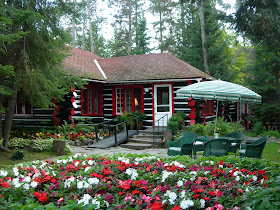Public parks, such as The Public Gardens of Halifax, Nova Scotia or the Dow's Lake park in Ottawa, are usually ornamented spaces with lawns, flower beds, and huge trees. Built to offer resting-places, paths and sometimes play areas. Today the Public Gardens of Halifax consist of winding paths, flower beds in geometric form surrounded by grass, borders of both perennials and annuals, statues, fountains, and a bandstand, the latter attesting to the Victorian taste for open-air musical performances.
The Royal Botanical Gardens of Hamilton consists of vast landscaped gardens including a notable collection of irises, a rock garden, a rose garden, an arboretum (including a lilac garden), a children's garden, a garden with medicinal plants, natural areas for explaining ecosystems, as well as a program of courses and research.
In the first decades of the twentieth century, gardens were laid out next to schools so that the children could learn the rudiments of gardening. These gardens had a pedagogical function. In the same period, almost everywhere in the country, gardens were laid out next to small railway stations. They served to beautify the sites and, particularly in the West, to promote the development of new regions.
Residential gardens
They have a much more private, intimate character, whether they are pleasure gardens, vegetable or kitchen gardens or even small plots of aromatic herbs, laid out next to private or official residences. Maplelawn in Ottawa, built from 1831 to 1834 by William Thomson, a farmer, had an adjoining walled garden. In its early stages, it was probably a kitchen garden for the domestic use of the household.
Garden Styles
Style is the expression of an aesthetic ideal, a trend, a particular taste or a form peculiar to an era or a cultural group. In Canada, styles popular in France, England and the US have been relied on as models. However, the unique social, ecological, climatic or geographic conditions prevailing in Canada, as well as the limitations and possibilities inherent in the plant stock, have influenced Canadian versions of European and American styles.
.
In some regions, particularly BC and the western provinces, the influence of Japanese and Chinese styles has been important. The influence of ethno-cultural traditions is traceable in some gardens. And, of course, gardens can encompass more than one style or present a modern interpretation of a style from the past.
French-style gardens are those laid out during the age of New France in connection with political institutions or religious communities. With its geometric plan, flower beds, walkways, floral clumps and fruit trees, the garden of the Vieux-Séminaire des Sulpiciens on Notre-Dame Ouest in Montréal, dating from the late 17th century, is the best-preserved of the convent gardens in that city.
After the British conquest in 1759, British and Loyalist settlers introduced a new approach: vis-à-vis nature and landscape. In contrast to French formalism, the aesthetic theory featured natural and picturesque landscapes and was expressed in the choice of spectacular sites, and irregular contours. With their borders, lawns, winding paths and exotic trees, the grounds surrounding the Governor's House in St John's, Newfoundland illustrate this English fashion with its emphasis on picturesque effects.
Laid out in the 1870s, most likely following designs prepared by Frederick Law Olmsted, the Beechcroft estate at Roches Point in Ontario illustrates this natural approach with its vast green spaces, careful groupings of trees and judiciously chosen viewpoints.
Gardens described as gardenesque contain a great variety of flower borders and groves, fountains, urns and statues that give them an ornate character. With its statues, urns and flower borders, Lakehurst at Roches Point in Ontario illustrates this popular garden style as implemented during the second half of the 19th century in Canada.
Gardens designed and built at the beginning of the 20th century under the influence of the writings of Gertrude Jekyll emphasize perennial borders, rockeries and alpine plants. The rock-garden which Mary Stewart laid out at the Cataraqui estate in Sillery in the 1930s was inspired by this approach. On a different principle, many gardens created at this time mark a nostalgic return to the past by imitating concepts developed in Italy and France in the 18th and 19th centuries.
.
West Coast influences on the style of gardens emanate from California and the Orient, at the same time making use of the climatic and geographic conditions prevailing in this region of the country. It combines, for example, modern ideas about handling landscape with Japanese influence, at the same time creating a close relationship between the house and its garden.
The many Chinese and Japanese gardens on the West Coast are one indication of the contribution these cultures have made to BC. The Nitobe Memorial Garden at the University of British Columbia is an example of such a Japanese garden and the Japanese garden in the Butchart Gardens in Victoria, BC. Even the Botanical Garden of Montréal includes a Chinese garden, the Jardin du Lac de Rêve.
Historic gardens are much more than a pleasant ornamental and recreational décor. They bear witness to the aesthetic, social, cultural and environmental tastes and pre-occupations of a past - sometimes distant, sometimes relatively recent. They form an important part of our heritage, a rich heritage that should be preserved for future generations.
.
<><><><><>
.





